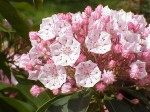 Growing four to twenty feet tall, this evergreen shrub is native to moist woods and clearings, and along streams from southern Maine south to northern Florida, and west to Indiana and Louisiana. It is a member of the heather family, Ericaceae, that also includes blueberries, cranberries, and rhododendrons. When grown in sufficient light, the bush is dense but if given insufficient light can become open and unattractive. This shrub naturalizes well and can be used in a foundation planting, partially shaded area, shrub border, or mixed border where it provides a good backdrop for annuals and perennials.
Growing four to twenty feet tall, this evergreen shrub is native to moist woods and clearings, and along streams from southern Maine south to northern Florida, and west to Indiana and Louisiana. It is a member of the heather family, Ericaceae, that also includes blueberries, cranberries, and rhododendrons. When grown in sufficient light, the bush is dense but if given insufficient light can become open and unattractive. This shrub naturalizes well and can be used in a foundation planting, partially shaded area, shrub border, or mixed border where it provides a good backdrop for annuals and perennials.
Description: The leathery glossy green leaves are up to five inches long, and are dark green above, yellow green below. The flowers appear in terminal clusters six inches across in late spring and range in color from rose-pink to white with purple markings. They are cup-shaped, one inch across, and give way to showy brown fruits that persist into winter.
Poisonous Properties: All parts of the plant are poisonous due to the presence of andromedotoxin, a resin, and to arbutin, a glucoside of hydroquinone. A burning of the lips, mouth and throat is followed within six hours by salivation, nausea, severe vomiting with abdominal pain, watering of the mouth, eyes, and nose, loss of appetite, repeated swallowing, headache, tingling of the skin, slow pulse, low blood pressure, drowsiness, convulsions, weakness, lack of coordination, difficulty breathing, and progressive paralysis followed by coma and death. Tea from the leaves and honey from the flowers as well as nectar from the flowers have caused problems in children. Mountain laurel has caused death in humans and livestock, particularly sheep and cattle although livestock usually avoid the plant if other food sources are available.